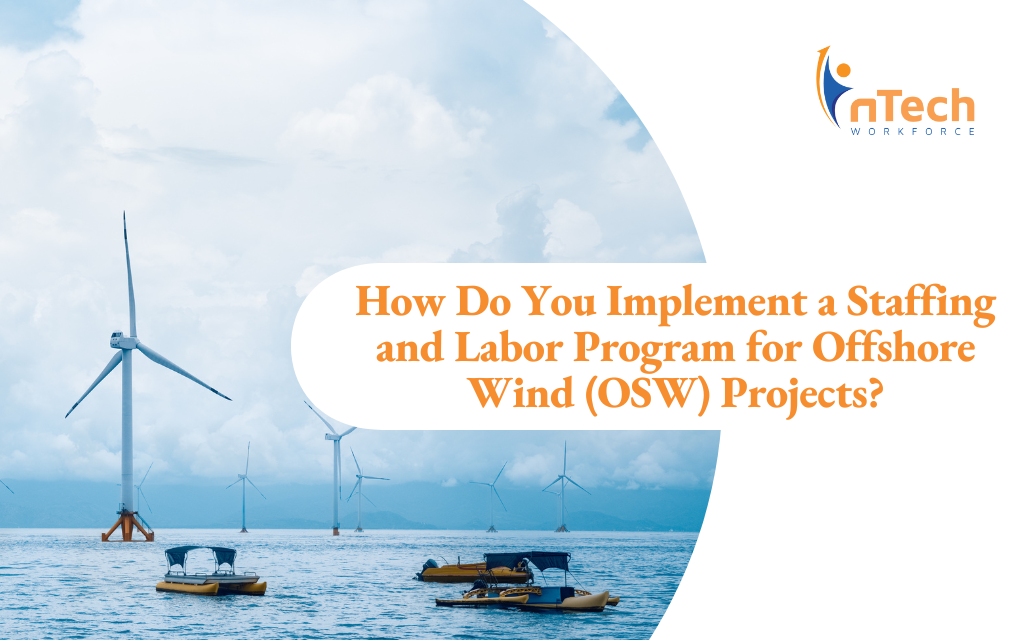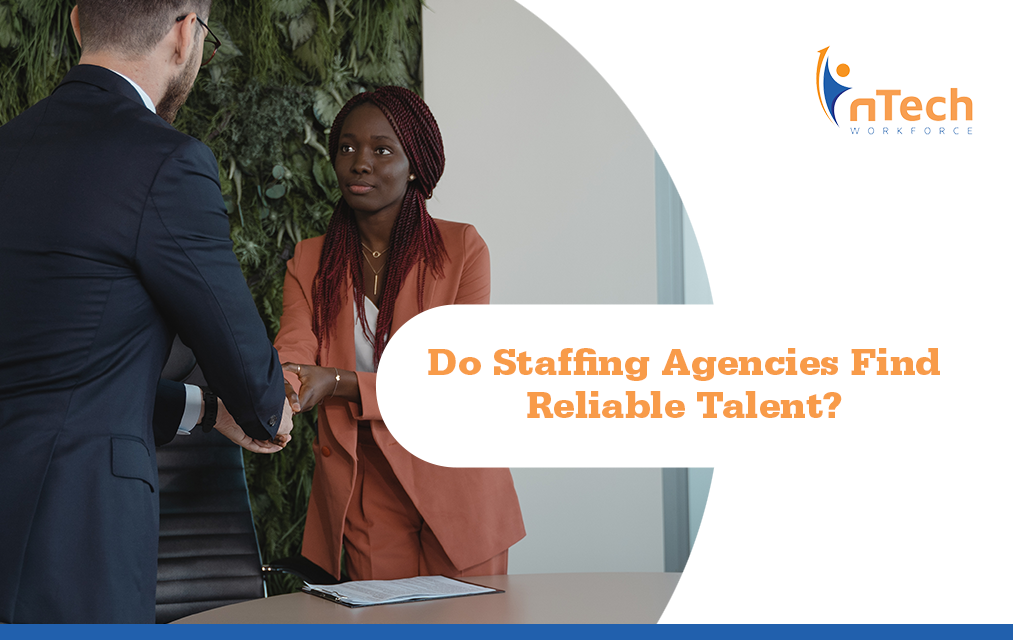Do Staffing Agencies Find Reliable Talent?
With labor shortages and spending cuts going on simultaneously, it has never been more integral for companies to find top-tier, reliable talent.
11 min read
![]() nTech Workforce
:
Mar 2, 2023 3:00:00 PM
nTech Workforce
:
Mar 2, 2023 3:00:00 PM

OSW faces the same “war for talent” and general constraints as other sectors. An essential part of scaling and securing long-term return on investment (ROI) for developers is the foresight to build a system for knowledge sharing, training, and developing a world-class workforce.
Arthur Ransier, Director of Business Strategy at nTech Workforce, states, “Achieving net zero requires partnerships spanning the social, private, and public sectors. Together, we can train and prepare American workers for thousands of specialized manufacturing, construction, and maintenance jobs in offshore wind as part of our goals for sustainability.”
Before getting started, identifying a partner will involve evaluating potential partners to ensure their competencies align with your needs. Generally, that might include evaluating their abilities to build and manage a diverse workforce, maintain relationships with third parties (nonprofits, subcontractors, unions, trade associations), foster minority-business participation, establish a talent pipeline, and lead you through the process of building a staffing and labor program.
The right staffing and labor intermediary is a partner with existing relationships across the public, private, and social sectors and can articulate a path toward launching a program that secures your long-term investments and maximizes ROI. Throughout the entire implementation process -- including discovery, structuring the implementation, establishing program policies and business rules, defining the organizational structure and responsibilities, configuring systems infrastructure, building your supply chain, and launching your program -- you'll recognize a sound partner in effective communication and how they make you and the other stakeholders feel. If you feel great, chances are that others throughout the supply chain feel great, too.
In this phase, we are charting the course to guide the implementation. The kickoff or discovery phase for building a staffing and labor program involves gathering information, assessing needs, and developing a plan for the program.
You will want to invite internal supply chain stakeholders to the implementation team, conduct a kickoff with the steering committee, define a timeline and milestones, and sign an implementation plan with clearly defined commitments.
Your staffing and labor intermediary will initiate the implementation process with program partner(s) and conclude with a documented plan of project scope, breakdown of tasks, funding, risk management, stakeholder engagement, resource commitments, and quality assurances. The process generally includes the following steps:
It's important to identify key stakeholders who will be involved in the program, including executives, managers, your general contractor, human resources staff, finance and accounting, procurement, and other affected employees. These stakeholders should be engaged early on in the process and consulted throughout the project to ensure their needs are addressed and their input is considered.
Next, the project team should conduct a needs assessment to identify the current state of the organization's staffing and labor practices and any gaps or areas for improvement, which involves:
The first step is to define the scope of the project and clarify the goals and objectives of the staffing and labor program. This involves identifying the needs of the organization and stakeholders, understanding the challenges and opportunities, and setting clear expectations for the program.
Based on the needs assessment and stakeholder input, the project team should develop a detailed project plan that outlines the scope, goals, timeline, and budget for the staffing and labor program. The plan should also include clear milestones, deliverables, and roles and responsibilities for each team member.
The project team should establish performance metrics that will be used to measure the success of the staffing and labor program. These metrics should align with the program's goals and objectives and be specific, measurable, achievable, relevant, and time-bound (SMART).
Based on the needs assessment and stakeholder input, the project team should develop new policies and procedures or update existing ones to support the staffing and labor program. These policies should be clear, concise, and aligned with the organization's overall goals and objectives.
To ensure the success of the staffing and labor program, it's essential to develop comprehensive training and communication plans that engage and educate employees, managers, and other stakeholders about the program's goals, policies, and procedures.
By following these steps, the project team can ensure that the staffing and labor program is well-planned, well-executed, and well-supported by stakeholders, which can ultimately lead to a more efficient, effective, and productive workforce.
Defining policies and business rules is a critical step in implementing a staffing and labor program. Policies and business rules provide the framework for managing staffing and labor processes and procedures, including the allocation of resources, the hiring of new employees, and the management of existing staff.
Key steps include assembling stakeholders and subject-matter experts, creating a program charter, agreeing to a program workflow diagram, incorporating legal requirements, and facilitating new policy integration through change management and good communication. Additional steps may include reviewing pre-existing contractual obligations, determining internal and external process support responsibilities, defining roles and resources, defining service-level agreements and remediation practices, and building reporting and communications infrastructure.
Here are some key elements that go into defining policies and business rules for a staffing and labor program:
The number of employees required, their skills and qualifications, and the roles and responsibilities they will perform information can be gathered through workforce planning and job analysis. Such staffing requirements are critical for defining workflows, resource planning, and building the infrastructure needed to scale a program.
Policies and business rules should define the recruitment and hiring process, including how job postings will be advertised, how resumes and applications will be reviewed, how interviews will be conducted, and how job offers will be made.
Jimmy Iannuzzi, Vice President and General Manager at nTech Workforce, adds, “Of the many strategic decisions being made during this process, how your brand is leveraged during the recruiting process is key.”
Your staffing and labor intermediary must understand the various categories of workers in the organization, such as full-time, part-time, temporary, and contract workers. This information should also include how employee classification affects benefits and compensation. Worker misclassification is a serious risk that should be managed accordingly.
Work schedules and hours – including how many hours employees are expected to work, how overtime is managed, and how breaks and lunch periods are allocated – are complex and sensitive areas of workforce management. Your staffing and labor intermediary must know your expectations to ensure those are flowed down, contractually, in contracts, work orders, and frequent communications with subcontractors. Furthermore, your staffing and labor intermediary – including their team of tax, labor, and employment attorneys – may advise on managing associated risk.
Policies and business rules should define compensation and benefits for employees, including the types of benefits offered, such as health insurance, retirement plans, and paid time off, and how compensation is determined, such as hourly or salaried pay.
How employee performance will be managed – including performance evaluations, goalsetting, workforce development, rewards, and recognition – should be aligned with organizational needs.
Employee relations – from grievances, conflict resolution, and disciplinary action to employee safety, company celebrations, and other engagements – must be aligned with the overall culture, values, and established roadmap.
Policies and business rules should define how the organization will comply with labor laws and regulations, including how it will manage overtime, how it will pay employees, and how it will manage workplace safety.
Policies and business rules should define how the organization will continuously improve its staffing and labor practices. This can include regular reviews of policies and procedures, ongoing training for managers and employees, and a process for soliciting feedback and making improvements.
Defining policies and business rules for a staffing and labor program requires careful planning, collaboration, and consultation with stakeholders. When done correctly, policies and business rules can help ensure a consistent and fair approach to staffing and labor management and support the organization's overall business objectives.
The systems infrastructure for a staffing and labor program should be configured in a way that maximizes ROI by improving the efficiency and effectiveness of workforce management processes. This includes configuring, testing, and deploying new systems to support contingent workforce transactions (e.g., work orders, timecards) and communications. Key steps include collecting workflow and reporting requirements, defining functional requirements per business scenarios, and building system components. nTech Workforce prioritizes ensuring systems align with the business context by engaging stakeholders and pairing business scenarios and specifications. Additionally, end-to-end quality assurance for workflow and reporting systems is an essential step in this process. Here are some key factors to consider when configuring the systems infrastructure for a staffing and labor program to ensure maximum ROI:
The staffing and labor program should be integrated with other systems, such as the human resources information system (HRIS), payroll, and time and attendance systems, to ensure that data flows seamlessly between systems. This integration can help reduce manual data entry and improve the accuracy of data.
The staffing and labor program should be designed to scale as the organization grows and changes. This can include the ability to add new users and locations, handle larger volumes of data, and support new workforce management processes as they are implemented.
The staffing and labor program should be configurable and customizable to meet the specific needs of the organization. This can include the ability to customize workflows, forms, and reports to support unique staffing and labor processes.
The staffing and labor program should be accessible via mobile devices to allow managers and employees to access workforce management processes from anywhere, at any time.
The staffing and labor program should provide robust reporting and analytics capabilities to enable data-driven decision-making. This can include real-time dashboards, customized reports, and analytics that help identify trends and areas for improvement.
The staffing and labor program should include automation capabilities that help streamline workforce management processes. This can include automated notifications and reminders, as well as the ability to automate repetitive tasks, such as scheduling and time tracking.
As noted in the Global Wind Energy Council 2022 Global Offshore Wind Report, "The adoption of newer manufacturing technology for offshore wind will drive the requirements to deliver consistent quality, with reduced production, fabrication, and installation cost."
The staffing and labor program should be designed with security in mind, with appropriate access controls and data encryption to protect sensitive workforce data.
The staffing and labor program should be designed with user adoption in mind, with an intuitive interface and user-friendly workflows that encourage adoption and ease of use.
What are the best vendor management systems in staffing?
By configuring the systems infrastructure for a staffing and labor program in a way that maximizes ROI, organizations can achieve greater efficiency and effectiveness in managing their workforce, leading to improved productivity, reduced labor costs, and better overall business outcomes.
Setting up a staffing and labor supply chain involves establishing a process for sourcing, contracting, managing, and retaining the outsourced workforce needed to meet the organization's staffing needs. The process of sourcing contractors, subcontractors, and workers for offshore wind projects is a multi-step process that involves identifying and recruiting qualified individuals and organizations to meet the specific needs of a project or company.
This includes assembling internal and external supply chain resources, such as unions, union contractors, trade associations, staffing agencies, drug and background providers, technology partners, etc. Your staffing intermediary should proactively engage unions, area nonprofits, and local minority-owned businesses to ensure visibility, incorporate their feedback, and demonstrate a commitment to ongoing collaboration. Key steps to follow include negotiating contracts and handling objections, monitoring supplier onboarding, and launching internal marketing campaigns to promote program benefits.
Here are some key steps to consider when setting up an outsourced staffing and labor supply chain:
Identify outsourcing providers through research and referrals, and evaluate their capabilities, reputation, and pricing. Determine the most effective provider(s) to meet the organization's staffing needs. In addition to skilled fabricators, welders, machine operators, and more hands-on jobs, the "factory of the future" — as outlined in a case study of the Lincoln Electric Company — demands skilled detailers, technologists, and "... the integration of advanced adaptive process controls, industrial robots, and customized hard automation and metal processing equipment... "
What is a staffing company? Why do I need one?
Develop a contracting process that includes scoping, pricing, and service level agreements. The contracting process should outline the terms of the relationship, including the services to be provided, performance expectations, and pricing structure.
Establish processes for managing the outsourced workforce, including communication, collaboration, and issue resolution. Ensure that the outsourced workforce is integrated with the organization's processes and culture and that they have the necessary training and resources to perform their work effectively.
Develop strategies for retaining the outsourced workforce, such as providing clear performance expectations, opportunities for learning and development, and a positive work environment.
Establish metrics for tracking the effectiveness of the outsourced staffing and labor supply chain, such as service quality, compliance with service level agreements, and cost savings. Use this data to identify areas for improvement and to refine the outsourcing process.
Why is detailed assignment feedback important to staffing partners?
Setting up an outsourced staffing and labor supply chain requires careful planning and ongoing attention to detail. By developing a process for sourcing, contracting, managing, and retaining the outsourced workforce, organizations can ensure that they have the right people in place to support their business objectives while maximizing cost savings and efficiencies.
A successful launch of an outsourced staffing and labor program requires careful planning, effective communication, and a collaborative approach. When the rubber meets the road, your staffing and labor intermediary should focus on exceeding expectations by completing projects in a timely and economical manner and by delivering at or above service-level agreements (SLAs). They should maximize the value of talent, control spending, ensure minority-business participation goals are met, and improve the developer’s return on investment. Here are some key factors that can contribute to a successful launch:
Establish clear objectives and expectations for the outsourced staffing and labor program, including the desired outcomes, timeline, and budget. Ensure that these objectives align with the organization's overall business strategy and goals.
Establish open and transparent communication with the outsourcing provider, including regular check-ins and status updates. Ensure that both parties have a clear understanding of their roles and responsibilities and that there is a clear escalation path for issues and concerns. Your staffing and labor intermediary should review the program launch checklist, send a launch announcement, and communicate the value proposition to a broad audience of stakeholders.
nTech’s Jimmy Iannuzzi recognizes that establishing effective communication from the beginning is a key step in developing a partnership with staffing suppliers, “While internal stakeholder buy-in and engagement is key, it is also true of your staffing suppliers. Too often, staffing suppliers are treated as a necessary evil, with information flowing on a very as-needed basis. When the communication comes through the lens of partnership, you will maximize the benefits of these relationships, with loyalty and grit being returned.”
Foster a collaborative working relationship with the outsourcing provider, based on trust, respect, and mutual benefit. Work together to develop effective processes and procedures, and ensure that the outsourced workforce is integrated with the organization's culture and processes.
Steve McNamara, Director of Talent Delivery at nTech Workforce, has over a decade of experience operating within a managed (staffing) services provider (MSP) model – predominately on the staffing supplier side – and has a unique perspective of how important consistent collaboration is to a successful staffing program, “When [collaboration] does not exist, failure is almost always assured. Defined expectations and accountabilities from both the outsourcing provider and the managed service provider around communication, timelines, compliance, and performance measurement are imperative to a collaborative and effective overall operation.”
When launching an outsourced staffing and labor program, training for internal and external resources is essential to ensure that both the outsourcing provider and the organization have the necessary knowledge and skills to support the program effectively. The training needed includes providing an overview of the program, training on processes and procedures, compliance and legal requirements, performance management, cultural orientation, and technical training on tools and systems. By providing comprehensive training on these key areas, organizations can ensure that the program is successful and compliant with all legal and regulatory requirements.
Develop robust processes for managing the outsourced staffing and labor program, including communication, issue resolution, and performance management. Ensure that these processes are aligned with the organization's overall processes and procedures and that they are reviewed and updated regularly. Processes and systems exist to enable your business – not inhibit it – which is why nTech and its partners conduct end-to-end testing in production and soft launch systems ahead of schedule to ensure reliable systems integrations.
Establish metrics for monitoring the effectiveness of the outsourced staffing and labor program, including service quality, compliance with service level agreements, and cost savings. Monitor these metrics closely, and use them to identify areas for improvement and to refine the outsourcing program over time.
Foster a culture of continuous improvement, based on ongoing learning and feedback. Encourage both the staffing and labor intermediary and key stakeholders to share best practices and ideas for improving the program, and to work together to drive innovation and value. They should ensure the accessibility of feedback and performance data through process automation and a central data repository, report back to internal customers with the status of improvement ideas, regularly execute the improvement plan, and highlight upcoming changes and benefits.
By focusing on these key factors, organizations can launch a staffing and labor program successfully, ensuring that they have the right people in place to support their business objectives while maximizing cost savings and efficiencies.
nTech Implementation Processes
nTech is a pacesetter in sustainable economic development, both through our solutions and through corporate philanthropy; our in-house learning and development team, LEVEL-UP service, and involvement with community-based organizations enable us to further add value for our clients by improving the reliability of talent pipelines. nTech’s operations are ISO/IEC 20000-1:2018-certified.
The best way to increase minority-owned business participation is to empower one with staffing and labor responsibilities. We are a minority-owned business enterprise (MBE) with decades of experience in managing complex projects involving dozens of stakeholders. We have deep relationships throughout Maryland – spanning the public, private, and social sectors – with policymaker support for our LEVEL-UP training program. At the center of our solutions, systems for supplier engagement, performance management, and reporting – and the teams that administer them – generate long-term value for our clients by fostering an environment of transparency and collaboration that enables us to address the needs of all stakeholders proactively and creatively.

With labor shortages and spending cuts going on simultaneously, it has never been more integral for companies to find top-tier, reliable talent.

Arthur Ransier, Director of Business Strategy at nTech Workforce, highlights this monumental opportunity for offshore wind investors and contractors,...

As your software business grows, DevOps (Development and Operations) optimizes efficiency and drives results toward company goals. What’s more,...